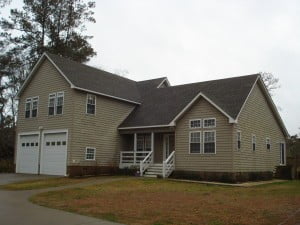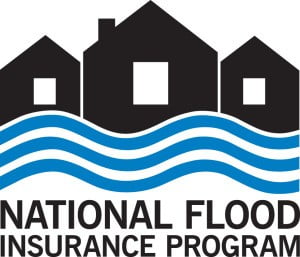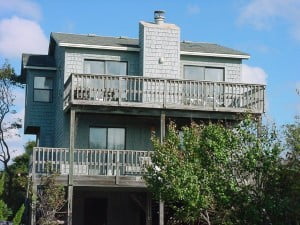Guests love this home and so will you!
Extra Large Custom Built Home on the Outer Banks
 You will love coming home to this custom built extra large home on one of the most popular streets in Kitty Hawk. So much attention to detail was paid when building this excellent family home. First floor master, HUGE bathroom, 2 closets, hall bath, gas fireplace with stone face, Australian Cypress floors, formal dining room, office area, ocket doors, pantry, large laundry area, huge eat in kitchen with Jenn-Air, wine cooler, butcher block island, granite countertops and stainless appliances all make up the first floor. The extra large garage has 10 foot doors for taller vehicles
You will love coming home to this custom built extra large home on one of the most popular streets in Kitty Hawk. So much attention to detail was paid when building this excellent family home. First floor master, HUGE bathroom, 2 closets, hall bath, gas fireplace with stone face, Australian Cypress floors, formal dining room, office area, ocket doors, pantry, large laundry area, huge eat in kitchen with Jenn-Air, wine cooler, butcher block island, granite countertops and stainless appliances all make up the first floor. The extra large garage has 10 foot doors for taller vehicles
HOMEOWNERS INSURANCE RATE SETTLEMENT REACHED
Press Release from the Outer Banks Association of Realtors(r)
OBAR and OBHBA learned earlier today that NC Department of Insurance Commissioner Wayne Goodwin reached a settlement agreement with the NC Rate Bureau on the Homeowners Insurance Rate Filing that was submitted in October 2012. A public comment period was held on the filing shortly thereafter and over 9,000 comments were submitted. The NC Department of Insurance, upon reviewing of the filing and consideration of the comments, issued a Notice of Hearing on the filing to begin June 3, 2013. The Hearing will no longer be held. It would have been the first on a Homeowners Insurance Rate Filing since 1993 and would have given NCDOI the opportunity to further scrutinize the filing through testimony and evidence submitted by the NC Rate Bureau.
NC DOI called the hearing for numerous reasons:
- “The data contained therein are so questionable that a property evaluation ……..is obstructed.
- In many instances the filing lacks necessary data, documentation and explanations of methodology to meet the Bureau’s statutory burden of proof.
- The filing is not clear, concise, internally consistent or readily understandable.
- Due consideration has not been given to actual loss and expense experience within this State for the most recent three-year and five-year periods fo which such information is available.
- The “net cost of reinsurance” provision in the filing appears to disregard the actual reinsurance experience in NC.
- The filing appears to disregard the actual hurricane loss experience in NC.
- The AIR computer model results are based upon outdated data and experience.
- Evaluating the AIR Model is impeded by the fact that numerous assumptions, parameters, formulas, data and other components underlying that model have not been disclosed.”
- and more!
To review the full Notice of Hearing go to:http://www.ncdoi.com/media/
The NC Rate Bureau’s filing represented a 30% rate increase for eighteen NC coastal counties. Based on filing data however, indicated rates – those the Rate Bureau concluded were the actuarial sound rates needed – were as high as 119% more than current rates. The NC Rate Bureau capped the increase request at 30%.
This settlement agreement represents an overall statewide increase of 7% with the largest increases impacting coastal counties. The beach areas of the coast will see increases as of July 1, 2013 as high as almost 20%; inland coastal areas will see much lower increases. Homeowners insurance policyholders with NCIUA (Beach Plan) wind coverage will be impacted the greatest, since the largest portion of the rate is for wind coverage and NCIUA policies pay above the maximum approved rate. There are approximately 135,000 homeowners – wind only policyholders covered by the NCIUA.
The settlement agreement will cause rates to be higher than rates that have been in place since 1993 in Charlotte and 32 other NC counties. The increase in those areas is as much as 8.4% – an increase from $529 to $574, a difference of only $45 in twenty years. The below map outlines the impact of the increases on coastal North Carolina policyholders.
Check out the by North Carolina Homeowners Rate Revision Breakdown by Territory CLICKING HERE!
DEADLINE MARCH 15- Homeowners Insurance Survey
NC Senate Majority Leader Harry Brown recently shared that he received more calls and complaints to his office about homeowners insurance than any other issue. As noted above, rates are going up by as much as 17% in Dare, Currituck and Hyde counties and policyholders are facing even much flood insurance premiums due to Congressional NFIP reforms passed last year.
Please encourage those concerned about the rising costs to participate in a homeowners insurance survey. The survey has been developed by a multi-coastal-state coalition working to improve access to homeowners’ insurance coverage and the affordability of coverage for coastal policyholders.
MORE PARTICIPANTS ARE NEEDED! The survey deadline has been extended to March 15th. Please continue to share this survey with property owners, family and friends and encourage them to fill it out.
United Policyholders is hosting the survey. Their home page – www.uphelp.org – will have a pop-up window that will direct you to the survey or you can find it directly at http://www.uphelp.org/home-
140 Old Duck Rd in Duck Village has a New Price!
Easy floor plan with three bedrooms and a full bath on the mid level, larger bedroom, dining area, living room and kitchen on the top level. Lots of light, great sun deck, very short walk to the uncrowded beach. Right in Duck Village you’ll love hearing the ocean as you sip coffee on the deck in the mornings. Or watch the sun go down and smell the ocean spray with a glass of wine. Hardwood floors in the living room and large bedroom upstairs. Tile in the kitchen/dining/entry way. Decent sized closets and a laundry area inside the home.
Best Buys for the week of March 4th
Contact Me About Any of These Properties!
Best Buys for the Week of February 25th
Contact Me About Any of These Properties!
Crucial Information regarding changes IN FORCE for the National Flood Insurance Program
 For the last several years the National Flood Insurance Program (NFIP) has experienced periods of expiration and availability of issuance policies. Each time Congress would pass a temporary bill extending the program for another short period. Finally a bill was introduced that would extend the program for 5 years and not have these continued interruptions. What we didn’t know existed in the several thousand pages of The Biggert-Water Act of 2012 were the changes in premiums and coverage that I will highlight below.
For the last several years the National Flood Insurance Program (NFIP) has experienced periods of expiration and availability of issuance policies. Each time Congress would pass a temporary bill extending the program for another short period. Finally a bill was introduced that would extend the program for 5 years and not have these continued interruptions. What we didn’t know existed in the several thousand pages of The Biggert-Water Act of 2012 were the changes in premiums and coverage that I will highlight below.
- First, these changes are not being imposed by FEMA or by the NFIP. These are legislative changes from Congress that can be undone by Congress with the right voices being heard.
- Starting January 1, 2013, any non-primary resident home that was built before flood maps were instituted (this is called Pre-FIRM) will see an increase in their premiums as the “discounts/subsidies” are removed.
- Starting August 1, 2013 commercial properties will have their subsidies/discounts removed and the new premium in place 25% per year for 4 years. For example, if the NEW, non-discounted premium is $5,000 per year and the old premium was $500 per year, the difference is $4500. The increase of the $4500 will apply 25% at a time over the next 4 years until the full premium of $5,000 is paid.
- Starting August 1, 2013, subsidies will be similarly phased out at 25 percent a year for severe repetitive (more than 4 claims) loss properties consisting of 1-4 residences, and properties that have incurred flood-related damages where claims payments exceed the fair market value. FYI – Severe Repetitive Loss means four or more claims payments of over $5,000 or two claims that exceed the value of the property.
- New policies written on pre-FIRM buildings (primary or non-primary residence) due to a sale or deliberate lapse will be issued at full-risk rates. THERE IS NO MORE GRANDFATHERING! Prior to the bill being passed, the flood map zone in effect at the time of construction remained with the house when it was sold.
- Beginning in 2014, premium rates for other properties, including non-subsidized properties – such as PRIMARY RESIDENCES AND SECOND HOMES BUILT AFTER 1974 – will increase as new or revised flood maps become effective. We are expecting new flood maps the latter part of 2014. This is not far off folks!
- Full risk rates will be phased in at 20% a year for five years for these properties. While FEMA works through the grandfathering issue on primary residences, they have removed the 2-year policy limit for the Preferred Risk Policy Extension until the new rates are implemented.
- When new flood maps become effective, they will include a rating for a new zone – a Coastal A Zone. This zone will affect areas behind the V-zone and other areas that experience a limit of wave action from 3 ft. to 1 ½ ft. For insurance purposes, a policyholder pays to the zone that touches his structure.
- Increases the limit for annual rate increases within any risk classification of structures from 10 percent to 20 percent. This means they can now raise your premium by 20% a year, anytime they deem necessary.
- Minimum annual deductibles on claims are changed to $1500 for coverage up to $100,000 and $2000 for coverage over $100,000 for pre-FIRM properties, and $1,000 and $1,250 for below and above $100,000 coverage for post-FIRM properties.
- Requires FEMA to notify property owners when their properties are included in, or are removed from, an area covered my mandatory insurance purchase requirements. Also requires notification of Senators and House Members whose States or Districts are affected by map changes.
- The Biggert-Waters Act of 2012 was included in H.R. 4348 – Surface Transportation Act found at http://www.gpo.gov/fdsys/pkg/BILLS-112hr4348enr/pdf/BILLS-112hr4348enr.pdf starting on page 512.
- You can help a Non-Profit coalition spearheading a movement on revising this bill by taking a quick survey about your current insurance http://www.uphelp.org/home-insurance-cost-and-quality-survey Your help is greatly appreciated!
These changes, if left in place, will have an impact on the local value of your property during a re-sale on the Outer Banks.
Please contact me with any questions you have regarding this. You can also contact your insurance agent to find out exactly what changes you can expect to your specific premiums. If you need information for another insurance agent, I’ll be happy to share the name of a trusted professional I work with regularly.
Best Buys for the week of February 18th
Contact Me About Any of These Properties!
Best Buys for the Week of February 11th
Contact Me About Any of These Properties!
January Snapshot for the Outer Banks
- Surprise! No news to report on the Mid-Currituck Bridge
- Actual Surprise – It SNOWED! It’s all gone now, but it was fun for a day
- The Great White Shark Mary Lee was cruising around Hatteras
- I was named Beach Realty’s 2012 Agent of the Year
- Sales for January have been STRONG. Over 50 properties CLOSED so far
- Over 200 properties have already had a price adjustment in January
- Nearly 200 new listings came on the market
- When priced correctly multiple offers are coming in!
- When priced correctly properties are selling within 30 days of listing
 Last year I predicted the sales for 2012 would increase 15%. The actual number was 21%! It was even better than I thought. This year I predict a similar trend. With the activity in the market so far we should easily exceed the number of sales over last year again. I also predict we will see a stabilization in pricing…no real movement up or down.
Last year I predicted the sales for 2012 would increase 15%. The actual number was 21%! It was even better than I thought. This year I predict a similar trend. With the activity in the market so far we should easily exceed the number of sales over last year again. I also predict we will see a stabilization in pricing…no real movement up or down.





